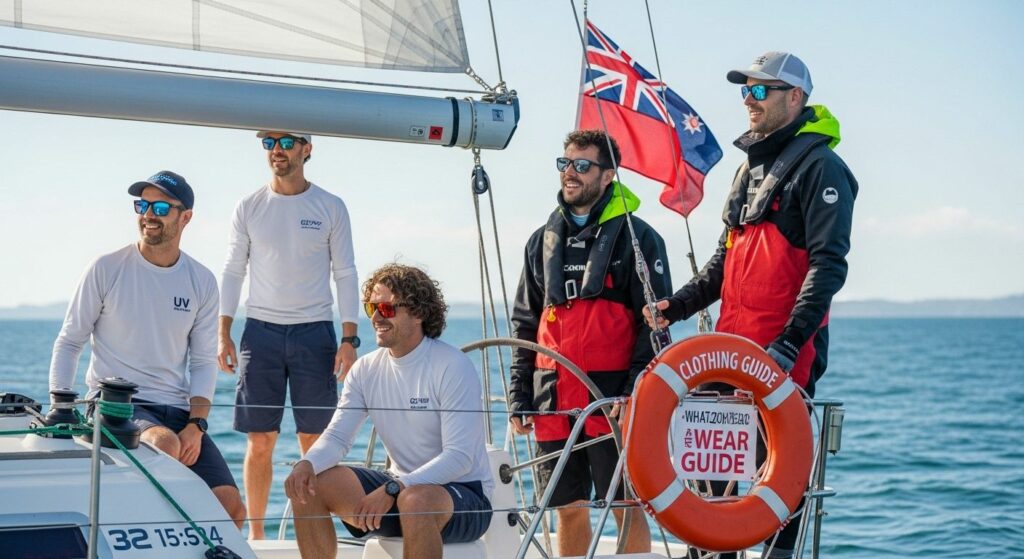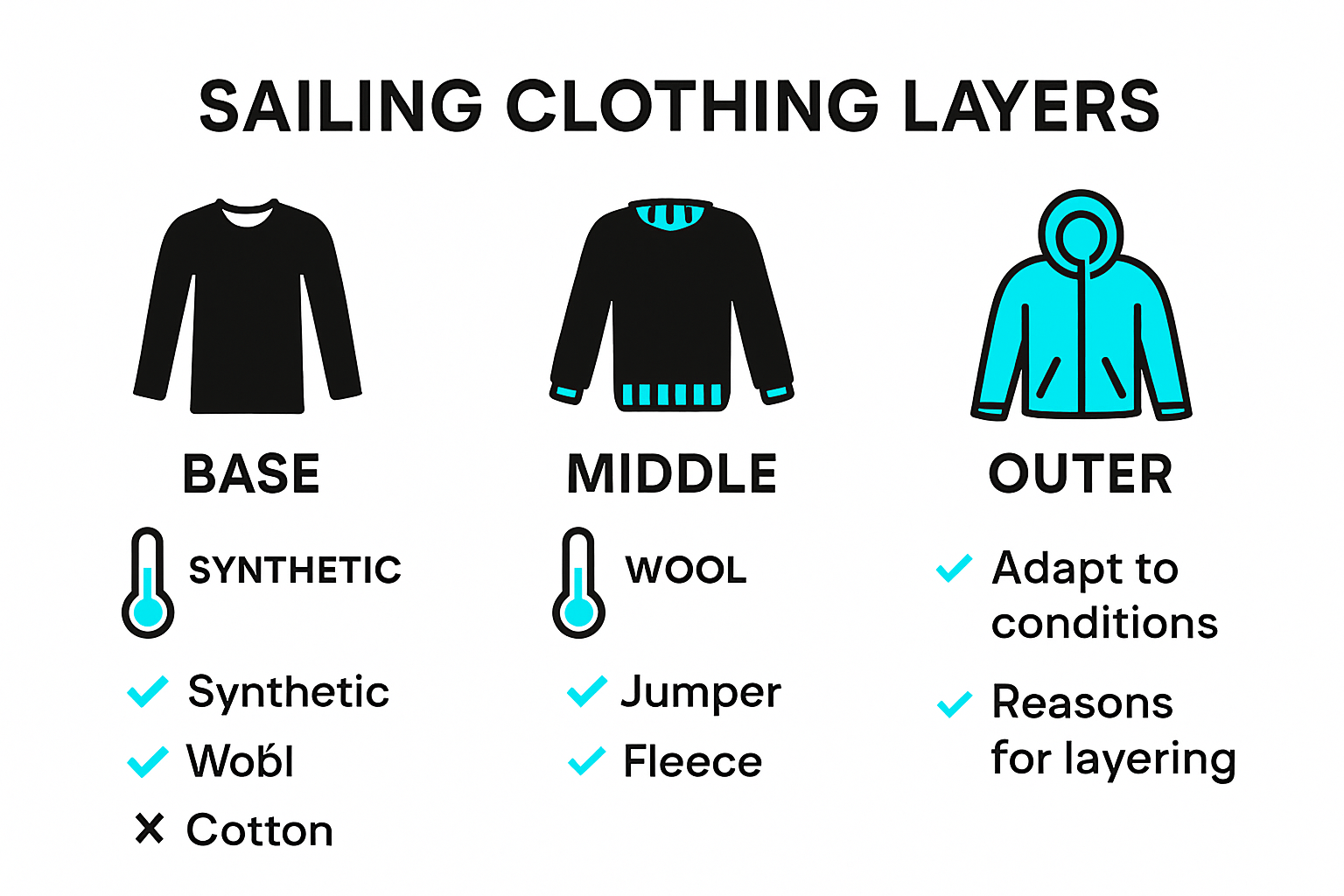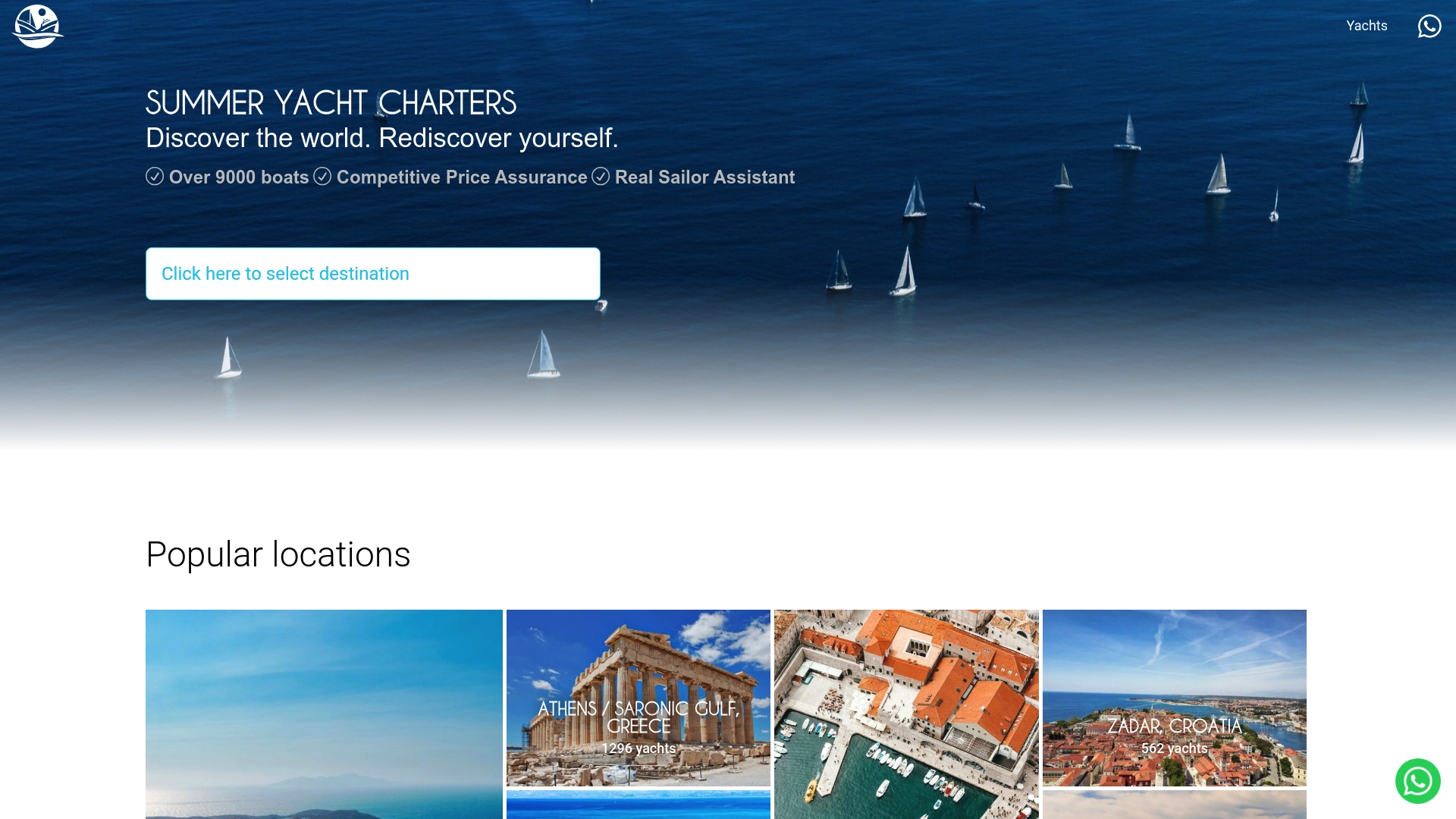What to Wear Sailing: Clothing Guide for Every Sailor
Discover what to wear sailing for safety, comfort and style. Get expert tips for seasoned skippers, luxury travellers, and adventurous crews.

Sailing offers some of the purest freedom and adventure on the water. The sights and wind in your hair are unforgettable, but the real difference often comes down to what you wear. Wearing the wrong clothing can turn a sunny sail into a miserable ordeal, and experts agree that layering with technical fabrics can reduce heat loss and discomfort by up to 80 percent. So while sleek yachts and stunning horizons might grab your attention, it is your choice of attire that truly decides how memorable your time at sea will be.
Table of Contents
- Choosing The Right Sailing Clothing Layers
- Essential Footwear And Accessories For Sailing
- Packing Guide For Different Sailing Destinations
- Sailing Style: Balancing Comfort, Function And Luxury
Quick Summary
| Takeaway | Explanation |
|---|---|
| Layer your clothing effectively | Use a base layer for moisture-wicking, an insulating middle layer, and a waterproof outer layer for optimal comfort and protection. |
| Choose proper sailing footwear | Select non-marking shoes with good grip. Close-toed options like boat shoes enhance safety and stability on wet decks. |
| Pack according to your sailing destination | Tailor your clothing and gear based on the climate and conditions of your sailing locations to ensure comfort and protection. |
| Invest in quality sailing accessories | Essential items like polarized sunglasses, wide-brimmed hats, and waterproof gear enhance safety and enjoyment on the water. |
| Balance style with functionality | Aim for sailing apparel that combines aesthetic appeal with performance features, ensuring comfort without compromising on style. |
Choosing the Right Sailing Clothing Layers
Successful sailing requires strategic clothing selection that protects you from changing maritime conditions while ensuring comfort and mobility. Understanding how to layer your clothing effectively is crucial for any sailor preparing to spend time on the water.
Base Layer: Your First Line of Defence
The base layer forms the foundation of your sailing wardrobe and plays a critical role in temperature regulation. According to the Duke of Edinburgh’s Award expedition guidance, your base layer should be tight-fitting and made from moisture-wicking materials that quickly draw sweat away from your skin. Synthetic fabrics like polyester and merino wool are ideal choices, as they provide excellent thermal management and dry rapidly.
Avoid cotton materials completely, as they retain moisture and can lead to rapid heat loss when wet. Opt for lightweight, breathable tops and bottoms that allow unrestricted movement. Consider long-sleeved options for sun protection and thermal regulation, especially during longer sailing trips.

Insulating Middle Layer: Trapping Warmth
Your middle layer is responsible for trapping body heat and providing insulation against cold winds and temperatures. Fleece jackets, lightweight wool sweaters, and technical synthetic materials work exceptionally well for this purpose. The key is to choose garments that offer warmth without excessive bulk, allowing you to maintain mobility while sailing.
Look for middle layers with features like zippered sections for ventilation and lightweight construction. These pieces should be easy to put on and remove as temperatures fluctuate throughout the day. Layering multiple thin pieces provides more flexibility than wearing one thick garment.
Outer Layer: Protection from Wind and Water
The outer layer is your primary defence against maritime elements like wind, spray, and potential rain. A high-quality waterproof and windproof sailing jacket is essential. Seek out sailing-specific jackets with sealed seams, adjustable cuffs, and breathable membranes that prevent water penetration while allowing moisture to escape.
Choose jackets and pants with reinforced areas in high-wear locations, such as elbows and knees. Bright colours can also enhance visibility on the water, adding an important safety element to your sailing attire. If you’re interested in exploring more about selecting the perfect vessel for your sailing adventures, check out our comprehensive vessel selection guide.
Remember that effective layering is about adaptability. The ability to add or remove layers quickly allows you to maintain optimal comfort across changing maritime conditions. Invest in quality, technical garments designed specifically for sailing, and you’ll be prepared for whatever the sea brings your way.
To help you select the optimal clothing for each sailing layer, here’s a summary table of recommended materials, key features, and important tips discussed in the article:
| Layer | Recommended Materials | Key Features | Important Tips |
|---|---|---|---|
| Base Layer | Polyester, Merino Wool | Moisture-wicking, Breathable | Avoid cotton; opt for tight fit and consider sun protection. |
| Middle Layer | Fleece, Wool, Synthetics | Insulating, Lightweight, Flexible | Use zippered options for ventilation; layer thin pieces. |
| Outer Layer | Waterproof Breathable | Windproof, Waterproof, Reinforced | Choose sealed seams; bright colours enhance visibility. |
Essential Footwear and Accessories for Sailing
Preparing for a sailing adventure requires careful consideration of footwear and accessories that provide safety, comfort, and functionality on the water. The right gear can make a significant difference in your overall sailing experience.
Sailing Footwear: Safety and Performance
Choosing appropriate sailing footwear is crucial for maintaining grip and preventing accidents. According to the American Sailing Association, non-marking rubber-soled shoes are essential for excellent traction on wet surfaces. These specialized shoes prevent slipping and provide the stability needed when moving around a boat deck.
Buzzards Sailing School strictly mandates closed-toe shoes with high-traction surfaces. Boat shoes, specifically designed for maritime environments, offer the best combination of grip, comfort, and water resistance. Avoid flip-flops or open-toed sandals, as they compromise safety and do not provide adequate protection.
Specialized Footwear for Different Sailing Conditions
The type of sailing you plan determines your ideal footwear. As Sailing Chandlery explains, dinghy sailors might prefer dinghy boots that cover more of the feet and legs, providing protection during active sailing maneuvers like hiking. Yacht sailors typically opt for lighter sailing shoes that allow quick and agile movement across the deck.
Consider factors like water temperature, sailing intensity, and expected weather conditions when selecting your footwear. Neoprene sailing boots work well in colder environments, while lightweight mesh shoes are perfect for warm-water sailing destinations. If you’re planning an exciting maritime adventure, explore our guide to Mediterranean sailing destinations for inspiration on where to take your newly acquired sailing gear.
Below is a comparison of footwear types recommended for different sailing environments, including their features and best-use scenarios, based on the article’s guidance:
| Footwear Type | Features | Best For | Avoid In |
|---|---|---|---|
| Boat Shoes | Non-marking, Good grip, Closed-toe | Wet decks, Yacht sailing | Extremely cold conditions |
| Neoprene Boots | Insulated, Protective | Cold/maritime environments | Warm climates |
| Mesh Sailing Shoes | Lightweight, Quick-drying | Warm water destinations | Cold climates |
| Dinghy Boots | Leg coverage, High traction | Dinghy/active sailing | Large/comfortable yacht decks |
| Flip-flops/Sandals | Open-toed, Limited grip | (Not recommended) | Any sailing activity |
Essential Sailing Accessories
Beyond footwear, several accessories are critical for a safe and enjoyable sailing experience. Polarized sunglasses protect your eyes from glare and UV rays reflecting off the water. A wide-brimmed hat or sailing cap provides additional sun protection and helps regulate body temperature.
A good sailing watch or waterproof digital device can help track time, weather conditions, and navigation details. Consider accessories like waterproof phone cases, a compact first-aid kit, and quick-drying towels. Lightweight, quick-dry gloves can protect your hands during rope handling and provide additional grip in challenging conditions.
Remember that investing in high-quality, purpose-built sailing accessories is not just about comfort—it’s about ensuring your safety and enhancing your overall maritime experience. Choose gear that is durable, functional, and suited to your specific sailing needs.
Packing Guide for Different Sailing Destinations
Successful sailing adventures require strategic packing that adapts to varying maritime environments and destination-specific challenges. Understanding how to prepare your wardrobe and gear for different sailing locations ensures comfort, safety, and maximum enjoyment on the water.
Tropical and Warm Water Destinations
When sailing in tropical regions, lightweight and breathable clothing becomes paramount. Pack moisture-wicking short-sleeved shirts, quick-drying shorts, and lightweight trousers made from synthetic materials that offer sun protection. According to Sail Magazine’s tropical sailing guide, UV-protective clothing with a high UPF rating can significantly reduce sun exposure and potential skin damage.
Accessories are crucial in warm environments. Bring a wide-brimmed hat, high-SPF sunscreen, and polarized sunglasses to protect against intense sunlight and glare. Lightweight, long-sleeved rash guards can provide additional sun protection while remaining comfortable in high temperatures. If you’re planning a romantic getaway in these stunning locations, explore our curated sailing destinations for couples to find your perfect maritime escape.
Mediterranean and Temperate Sailing Regions
Mediterranean sailing destinations require a more versatile approach to packing. Layering becomes essential as temperatures can fluctuate significantly between day and night. Pack lightweight base layers, a waterproof jacket, and a few warmer mid-layers that can be easily added or removed. Cruising World recommends bringing windproof outer layers and thermal underwear for cooler evenings and early mornings.
Consider the cultural norms of specific Mediterranean destinations. Some coastal towns and islands have more conservative dress codes, especially when visiting restaurants or historical sites. Pack a few smart casual options that can transition from sailing attire to evening wear. Lightweight, wrinkle-resistant fabrics work best for these versatile outfits.
Northern and Cooler Maritime Environments
Sailing in cooler regions demands robust and insulating clothing strategies. Thermal base layers, waterproof sailing jackets, and thick sailing trousers become essential. Neoprene sailing gear, including gloves and boots, provides critical protection against cold water and wind chill. According to Practical Sailor, layering with technical fabrics that offer both warmth and moisture management is key to maintaining comfort in challenging maritime conditions.
Bring multiple sets of warm, quick-drying clothing and ensure you have sufficient waterproof gear. A good quality sailing suit or flotation jacket can make a significant difference in comfort and safety. Remember to pack extra warm socks, a thermal beanie, and neck gaiter to protect against wind and spray.
Regardless of your destination, comprehensive yacht vacation packing requires careful planning. Always check specific destination weather forecasts and local sailing conditions before finalizing your packing list. The key is to remain flexible, prepared, and ready to adapt to the dynamic nature of maritime environments.
Here’s an organised summary of packing considerations for the main sailing destination types mentioned, capturing essential clothing, layering needs, and accessories:
| Destination Type | Essential Clothing | Layering Advice | Key Accessories |
|---|---|---|---|
| Tropical/Warm Water | Short-sleeved shirts, shorts, rash guards | Light layers, breathable | Wide-brimmed hat, sunglasses, SPF |
| Mediterranean/Temperate | Base layers, jacket, smart casual options | Versatile, add/removable | Windproof outerwear, smart outfit |
| Northern/Cooler Maritime | Thermal base, waterproof jacket/trousers | Multiple insulating layers | Neoprene gear, warm hat, gloves |
Sailing Style: Balancing Comfort, Function and Luxury
Navigating the delicate balance between style, functionality, and comfort defines the modern sailor’s wardrobe. The right sailing attire goes beyond mere protection from maritime elements—it represents a sophisticated blend of performance technology and aesthetic appeal.
Performance Meets Elegance
According to Yachting World, successful offshore sailing demands a strategic approach to clothing that prioritizes both performance and comfort. Modern sailing apparel has evolved to offer multifunctional designs that transition seamlessly from deck to dining, eliminating the need for multiple outfit changes.
Innovative fabrics now provide UV protection, moisture-wicking capabilities, and temperature regulation in a single garment. Designers are creating clothing that looks sophisticated while offering the technical performance sailors require. Neutral color palettes like navy, white, and soft greys dominate sailing fashion, providing a timeless and versatile aesthetic that complements the maritime environment.
Technical Innovations in Sailing Wear
Yachting.com highlights emerging trends in sailing apparel that blur the lines between technology and fashion. Battery-powered clothing offers active warmth in challenging conditions, while advanced materials provide improved peripheral vision and unrestricted movement. Sailing wear now incorporates stretch fabrics, reinforced stress points, and ergonomic designs that cater to the dynamic movements required during sailing.
Accessories have also undergone significant transformation. Waterproof smartwatches, GPS-enabled sunglasses, and performance gloves with touchscreen compatibility represent the new frontier of sailing accessories. These innovations ensure sailors remain connected and protected without compromising on style. If you’re curious about experiencing the pinnacle of maritime luxury, explore our premium yacht charter experiences that complement these cutting-edge fashion trends.
Luxury and Functionality: A Harmonious Blend
Luxury in sailing style is no longer about conspicuous consumption but about intelligent design and subtle sophistication. High-end sailing brands now focus on creating garments that offer maximum functionality without sacrificing aesthetic appeal. Breathable jackets with hidden technical features, quick-drying trousers with tailored fits, and versatile layers that adapt to changing maritime conditions exemplify this philosophy.
Consider investing in pieces that offer versatility—a waterproof jacket that looks equally appropriate at a marina restaurant or on the boat’s deck, or a polo shirt that transitions from daytime sailing to evening socializing. The key is selecting garments that provide technical performance while maintaining an elevated, refined appearance.
Remember that true sailing style is about confidence, comfort, and respect for the maritime environment. Your clothing should not only protect you from the elements but also reflect the sophistication and adventurous spirit inherent in sailing culture. Choose wisely, and your maritime wardrobe will become an extension of your sailing persona.

Frequently Asked Questions
What should I wear as a base layer for sailing?
The base layer should be tight-fitting and made from moisture-wicking materials like polyester or merino wool. Avoid cotton as it retains moisture and can lead to heat loss.
How do I choose the right outer layer for sailing?
Select a high-quality waterproof and windproof sailing jacket with features like sealed seams and adjustable cuffs. Look for breathable materials to allow moisture to escape while keeping you dry.
What type of footwear is best for sailing?
Opt for non-marking, rubber-soled shoes that offer good grip for safety on wet surfaces. Closed-toed options like boat shoes are recommended for stability while moving around the deck.
How should I pack for sailing in different climates?
Adapt your packing to each destination’s climate. For tropical areas, focus on lightweight, breathable fabrics, while cooler regions require thermal layers and waterproof gear to keep you warm and dry.
Set Sail in Comfort and Confidence with Summer Yacht Charters
Every experienced sailor knows that wearing the right gear can transform a sailing holiday from challenging to blissful. Whether you are captivated by the unique layering tips for sun protection or the technical advantages of moisture-wicking clothing detailed above, your comfort and confidence on deck depend on more than your wardrobe alone. To truly make the most of your time at sea, you need a sailing experience that is just as carefully curated as your gear. If you are dreaming of exploring iconic locations such as the Cyclades or Ionian islands, start planning your journey with ease using our streamlined platform. Discover unforgettable yacht charters in the Cyclades and really make those sun-protective layers count on the glistening Aegean.

Preparation can only take you so far without the right sailing partner. At Summer Yacht Charters you can quickly match the perfect yacht to your itinerary, experience and group size. Use our expert support and innovative search tools to secure your next adventure today. Elevate every aspect of your sailing holiday and book the vessel that suits your style and destination while prime dates are still available.
Recommended
- Sailing Holidays for Couples: Discover Romantic Destinations – Summer Yacht Charters
- What Is a Yacht Charter? Essential Guide for 2025 – Summer Yacht Charters
- How to Anchor a Yacht Safely: Step-by-Step Guide – Summer Yacht Charters
- What Does a Skipper Do? Guide for Sailors & Travellers – Summer Yacht Charters